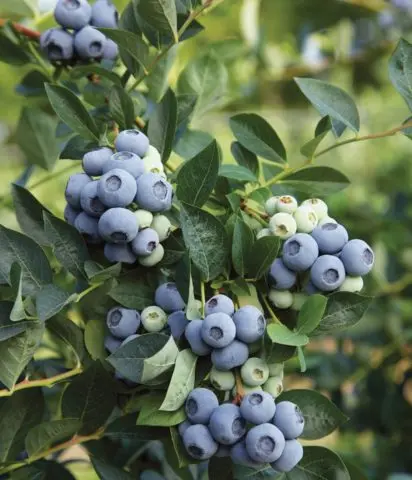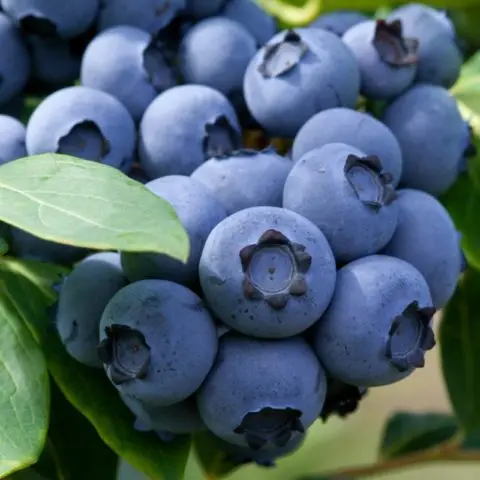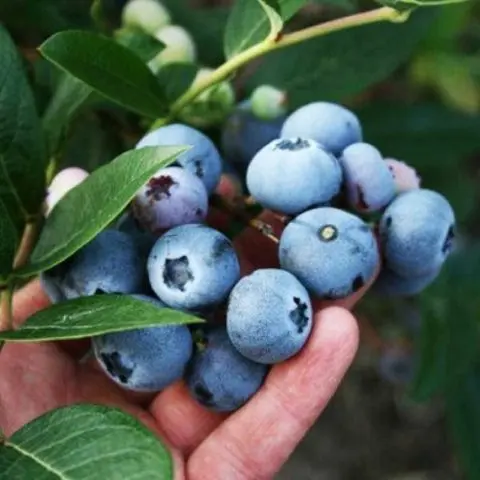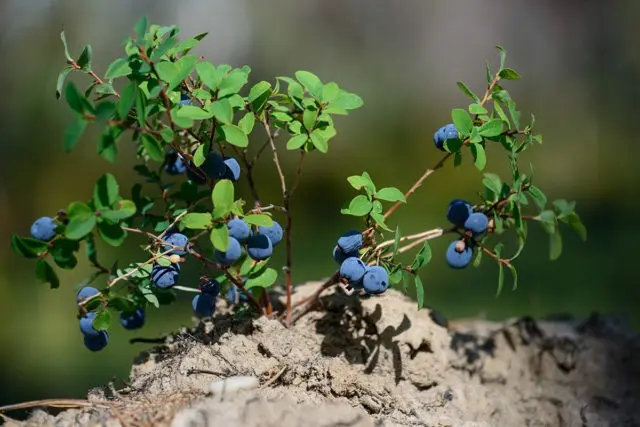Contents
The historical homeland of blueberries is North America. The distribution area of tall shrubs is floodplains, wetlands. The wild-growing species formed the basis for a large number of dessert varieties with good yields and high gastronomic appreciation. Blueberry Denis Blue is the result of New Zealand selection, the priority in the work was to create a variety adapted to cold climatic conditions. In Our Country, the culture is grown throughout the European part of the country; in 2013, Denis Blue blueberries are listed in the State Register.

Description of blueberry variety Deniz blue
Blueberry variety Denis Blue is a perennial deciduous shrub of spherical shape, by the age of six it grows up to 1,5 meters. Frost-resistant culture successfully resists temperatures down to -40 0C, freezing of shoots is rarely observed. The shrub is not afraid of a sharp change in temperature in the spring, because blueberries bloom later, after possible return frosts.
Blueberries are grown in Siberia, the Urals, in the Middle lane and the Moscow region for berries and as a design element in ornamental gardening. Denis Blue looks aesthetically pleasing from the moment of flowering until the autumn change of leaf color. In September, the crown becomes bright yellow, then the leaves acquire a burgundy hue, do not fall off until frost. Shrub densely branched, young shoots grow quickly and in large numbers.
External description of the garden blueberry variety Denis Blue:
- The stems are thin, upright, with slightly lowered tops, rigid, flexible, completely woody. The bark is smooth, light brown with a gray tint. Shrub rounded, overgrown in width, diameter – 1,3 m.
- Blueberry Denis Blue is densely leafy, the leaf plate is 3-3,5 cm long, obovate, lanceolate, the location is opposite. The surface is smooth, with a network of veins, glossy, green. The cuttings are hard, medium volume, long, dark beige.
- The flowering is plentiful, the flowers are light pink, small, pitcher-like, 6-10 pieces are formed on the fruit brush.
The root system is poorly developed, located close to the surface, the roots are thin, fibrous, they cannot provide Denis Blue blueberries with nutrients on their own. The peculiarity of the culture is a way to obtain the necessary trace elements, it consists in symbiosis with the mycelium of the fungus. Mycorrhiza provides the vital activity of both the fungus and the plant.
Features of fruiting
The blueberry variety Denis Blue is mid-season, the shrub blooms in June, the berries are harvested in the second half of August. Ripening is uniform, brushes are located on the outer part of the stems, easily accessible for picking fruits. Blueberry Denis Blue can give the first fruits in the third year of vegetation. The flowers are single, they are not left on the shrub, because the productivity of a young plant is low.
Full fruiting occurs at 5-6 years, the yield of the variety is high, 6-8 kg of berries are harvested from one bush. Blueberry is a dioecious plant, forms female and male flowers, cross-pollination. The variety can do without pollinators, but in this case, the yield drops. For a high fruiting rate, it is recommended to plant varieties with simultaneous flowering next to Denis Blue blueberries; Bluecrop, Northland blueberries are suitable as a pollinator.
The berries of the Denis Blue variety are of the same size, they are colored at the stage of technical ripeness, but they acquire a taste after 3 weeks. The fruits are not prone to shedding, are well fixed on the stalk, the separation is dry. In the sun with sufficient watering, they do not bake. In case of moisture deficiency, they grow smaller, sour, loose, lose their shape.

Description of blueberry fruits of the Denis Blue variety (shown in the photo):
- shape in the form of a circle compressed on both sides, weight – 1,9 g, diameter – 18 mm;
- the peel is strong, elastic, thin;
- blueberry is smooth, on top there is a small depression with a toothed receptacle;
- the color is dark blue with a silvery waxy coating, in a ripe berry the flesh is juicy, dense structure, light purple.
The presence of acid in the taste is minimal, the berry of the variety is sweet, with a slight aroma. They use fresh blueberries, process them into juice, produce wine, prepare jam and jam. Taste qualities do not lose after freezing. The variety Denis Blue is suitable for commercial cultivation, the fruits are stored for about 7 days, transported in a refrigerator with a temperature not higher than +5 0C.
Advantages and disadvantages
According to gardeners, the Deniz blueberry variety has a number of advantages:
- frost resistance;
- high yield;
- good taste;
- versatility in use;
- simple agricultural technology;
- fruiting duration.
The disadvantages include low drought resistance, intensive formation of young shoots, shrubs require pruning. Average resistance to infection.
Features of reproduction
Blueberry variety Denis Blue reproduces only vegetatively:
- Cuttings. Harvest material in the spring from last year’s shoots. The cuttings are placed in a nutrient substrate at an angle of 450, watered, covered for the winter, planted next year in the fall.
- By dividing the bush. Work is carried out after fruiting; for division, a shrub is taken at least 4 years old.
- Layers. In the spring, before sap flow, the lower branch is added dropwise, next spring plots are cut and planted on the site.
A prerequisite for self-propagation is that the topsoil must not be allowed to dry out.
Planting and caring for blueberries Denise blue
If planting is carried out with self-grown material, blueberries are disinfected with a 5% solution of manganese, the root is lowered for 4 hours. Then any growth stimulating drug is used, used in accordance with the instructions. If an acquired seedling is planted, it must be two years old without signs of mechanical and fungal damage.

Recommended dates
Blueberry variety Denis Blue is a frost-resistant representative of the species. Planting can be done in spring or autumn. In the first case, the terms depend on the characteristics of the climate, the main condition is the warming of the soil up to +8 0C. For the middle lane, the approximate time of spring planting is the beginning or middle of May. Autumn planting is carried out 1 month before the onset of frost, the survival rate of blueberries is high, this time is enough for the plant to take root.
Site selection and soil preparation
The blueberry variety Denis Blue does not tolerate even slight shading. Photosynthesis is completely dependent on the amount of ultraviolet light. In the shade, vegetation slows down, productivity decreases. A suitable site for blueberries is an open, well-ventilated space (the plant is not afraid of drafts). A wetland or lowland will do. The composition of the soil must be acidic. The site is dug up, a nutrient substrate is prepared from peat, sawdust, needles, sand.
Landing algorithm
A seedling with a closed root system purchased from a nursery is already supplied with mycelium. For self-grown material, mushroom spores are bought.
Landing sequence:
- They dig a hole with a diameter of 80 * 80 cm, a depth of 0,6 m.
- Pour ½ of the mixture to the bottom, fungus spores on top.
- They put the blueberries in the center, gently spread the roots along the bottom, they should completely cover the area with mycelium.
- Fall asleep with the rest of the substrate and soil.
- They tamp, water, mulch with sawdust mixed with peat or needles.
If several blueberry bushes are planted in one line, the interval between them is 1,5 m.
Cultivation and care
Properly carried out planting and compliance with the recommendations for care will provide Denis Blue blueberries with normal vegetation and high productivity. Agrotechnics includes: timely watering, fertilizing and maintaining the necessary soil acidity.
Watering Schedule
Blueberry variety Denis Blue is a non-drought resistant plant, so watering is required for the shrub. The roots are located close to the surface, so the soil must be constantly wet. But excessive watering should not be allowed, excess moisture can provoke root rot.
Watering is carried out in the morning and in the evening every other day. The daily norm is 5 liters. The frequency of watering is increased in July, because this time is the period of setting berries. At low humidity, the bush is sprinkled, the procedure will accelerate photosynthesis and protect blueberries from overheating.

Top dressing schedule
Feed blueberries Denise blue from the second year of growth. In the spring (before the leaves appear) with a nitrogen-containing agent, and at the time of the formation of the berries – with universal complex fertilizers or a mixture of potassium sulfate (35 g), ammonium sulfate (85 g) and superphosphate (105 g). Fertilizers are applied under the bush for 1 tbsp. l. After two years, the amount is doubled, the maximum dosage is 8 tbsp. l. for adult blueberries.
A mandatory procedure in agricultural technology is soil acidification. In a neutral or slightly acidic environment, fungi cannot exist; the death of one participant in the symbiosis affects the viability of the other. If the blueberry leaves turn white with a yellow or pink tint, this is the first sign that the soil acidity is low. If the acidity level is unsatisfactory, it is increased by adding 1m2 one of the means:
- citric acid or oxalic acid – 5 g / 10 l;
- apple cider vinegar – 100 g / 10 l;
- colloidal sulfur – 1 ml / 1 l;
- electrolyte – 30 ml / 10 l;
Blueberries react negatively to organic fertilizers; they are not used when growing crops.
Trimming
Pruning varieties Denis Blue begin at the age of three. Shoots are shortened in the spring by 1/3 of the length. The procedure is continued until the age of fruiting. After 5 years, blueberries are pruned in the fall, twisted branches are removed, the bush is thinned out. In the spring, frozen stems and dry areas are cut off.
Preparation for winter
A frost-resistant plant after five years of vegetation does not require crown shelter. If the shoots are damaged by frost, blueberries quickly form a replacement without loss of yield. In autumn, the bush is watered with a large volume of water and mulched with a layer of peat, wood chips or needles. Young seedlings, in addition to mulch, require crown shelter. The branches are pulled into a bundle, fixed. Arcs are placed near the blueberries, covering material is pulled.
Pests and diseases
For preventive purposes, along with sanitary pruning, blueberries of the Denis Blue variety are treated with fungicides. When a fungal infection occurs, “Fitosporin” is used, watered with a solution of “Fundazol”. They parasitize on shrubs: leafworm, flower beetle and beetle. Get rid of pests “Iskra”, “Inta-Virom”, “Fundazol”.
Conclusion
Blueberry Denis Blue is a garden variety with high yield, frost resistance and standard agricultural practices. Breeding culture created specifically for growing in cold climates. The shrub has an ornamental appearance and edible berries, so the culture is grown as an element of landscape design and for harvesting.









